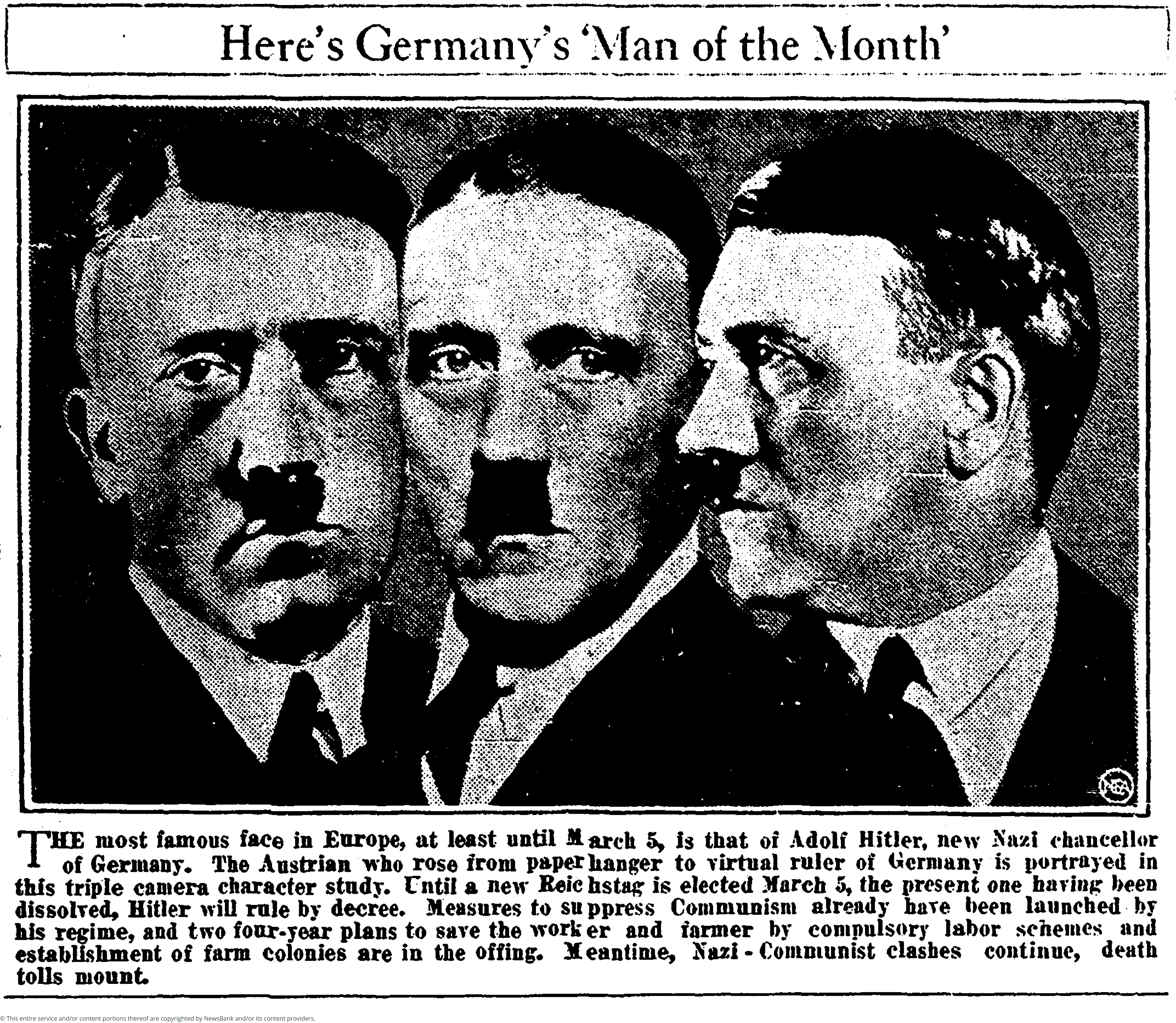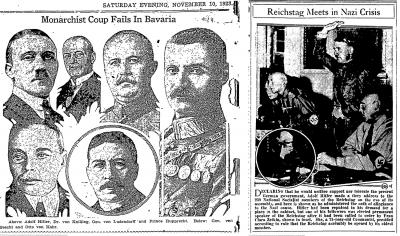80 Years Since World War II: From Hitler's Rise to Hiroshima's End
Psychology behind the atrocities continues to fascinate
Eighty years ago, World War II ended. On Aug. 6, 1945, an atomic bomb was dropped on Hiroshima, Japan. Three days later, a second atomic bomb was dropped on Nagasaki. On Aug. 15, Emperor Hirohito announced Japan's surrender, effectively ending the war. It was a violent and horrific conclusion to a violent and horrific war. The death toll of the previous six years was staggering, almost unfathomable. Estimates vary, but most experts suggest that somewhere between 50 to 80 million people died as a result of war. Tens of millions were civilians.
Adolf Hitler and the Nazi Party's rise to power in Germany is the subject of countless books, articles, and documentaries, but continues to fascinate. The German population's embrace of and obedience towards Nazism did not take place overnight. The evolution of Hitler's cult of personality, his ascent to power, and Germany's fall to authoritarianism was a slow and often calculated process.
It was 1919, only a year after he was injured near the First World War's end, when Adolf Hitler joined Anton Drexler's German Workers' Party. In early 1920, now rebranded as the Nazi Party, Hitler demonstrated his oratory skills explaining their official platform to a crowd of 2,000. They emphasized a unification of German people across Europe, expanding territory, preventing immigration of non-Germans, and removing non-Germans from the Reich. "None but those of German blood, whatever their creed, may be members of the nation," the platform demanded.
In the United States, the Nazis remained relatively unknown. On Sept. 29, 1923, the Erie Daily Times mentioned Hitler for the first time. The photograph, unmistakably him, was printed alongside a caption: "Adolf Hitler, leader of the German National Socialist Party, German Fascist, which is gaining so much headway in Bavaria."
The Nazi's Beer Hall Putsch in Munich was two months later. This failed coup d'état resulted in a conviction of treason and a 5-year prison sentence for Hitler. The putsch and its "Hitlerites" were covered extensively in American papers, including in Erie, where it was referred to as a "tragic comedy" with Hitler mocked as a Don Quixote. Despite its failure though, it provided the Nazis something else of value: visibility. After nine months, Hitler was released.
In July 1925, Hitler's Mein Kampf was published. In it, he specified racial purity as his "sacred mission" and wrote that "racially pure people" would always "master over bastards." He also promoted the increasingly popular "stab-in-the-back" myth of World War I's end – that Germany hadn't lost the war on the battlefields, but by backstabbing communists, socialists, and Jews pulling political strings. The Nazis still remained very much a fringe group. In 1989, a TIME Magazine story reflected how Hitler initially only "attracted those like himself, unappeased outsiders, misfits, [and] losers." They were growing though and their appeal soon broadened. To spread their ideologies further, Hitler wrote, the Nazis had to understand "the emotional ideas of the great masses" and then present their ideas "through a psychologically correct form." He referred to propaganda as an "art" that must be skillfully mastered.
"[Propaganda] consists in attracting the attention of the crowd, and not in educating those who are already educated," Hitler wrote, adding that the "power of forgetting is enormous" among the great masses. "[A]ll effective propaganda must be limited to a very few points and must harp on these in slogans until the last member of the public understands what you want him to understand by your slogan," he continued. "The function of propaganda … is not to make an objective study of the truth … its task is to serve our own right, always and unflinchingly."
In a later wartime psychological profile of Hitler, Walter C. Langer explained, "His primary rules were: never allow the public to cool off; never admit a fault or wrong; never concede that there may be some good in your enemy; never leave room for alternatives; never accept blame; concentrate on one enemy at a time and blame him for everything that goes wrong; people will believe a big lie sooner than a little one; and if you repeat it frequently enough people will sooner or later believe it."
He also learned from his mistakes. The putsch had failed. As explained by Holocaust historian Christopher R. Browning, "The Nazis would use the electoral process of democracy to destroy democracy." Propaganda was key and their propaganda machine was extremely effective especially as economic chaos increasingly destabilized Germany. Moderate German politicians and intellectuals, who had somewhat embraced post-war democratic reforms, attempted to hold onto the center, but polarization was widening at an alarming rate.
Meanwhile, back in Erie, years passed without a single mention of Hitler or the Nazis in local newspapers. The spread of Nazism was not yet something on most people's minds stateside, although there were plenty of articles about Benito Mussolini's fascist movement in Italy. After all, in Germany's 1928 federal elections, the Nazi Party only received 2.63 percent of the vote, giving the Nazis only 12 seats in a nearly 500-member Reichstag. By 1930 though, that increased to almost 20 percent, the second most of any party. In the Erie Daily Times, this put the Nazis back in the headlines. That September, they ran a story claiming that the Nazis planned to overthrow the republic with an army of streetfighters and storm divisions. Hitler denied claims that they were anything but peaceful.
"Adolf Hitler, bold man of German politics and head of the Fascists, unflinchingly ... proclaimed without hesitation that Fascism through peaceful means eventually was fated to conquer the nation," a report a few days later said. In a 1931 interview though, Hitler hinted otherwise, stating, "I will tolerate no opposition. We recognize only subordination."

ERIE DAILY TIMES - September 29, 1923
"The German problem cannot be laughed off," the Erie Daily Times editorialized. "Adolf Hitler [is] a stronger character than ever before and a force to be reckoned with in the near future." Only President Paul von Hindenburg, it was argued, remained as "the keystone in the conservative dam which is holding back the flood of radical and Fascist opinion" in Germany.
In January 1933, Hindenburg appointed Hitler as Reich Chancellor. The Reichstag was set on fire in late February, which the Nazis used as evidence of a communist conspiracy. On March 5, the Nazis received nearly 44 percent of the vote in the elections, making them Germany's leading party. Hitler immediately began shattering democratic norms and by the end of the month was handed dictatorial powers by the Reichstag with the passage of the Enabling Act. Then in August 1934, following the death of the 86-year-old Hindenburg, Hitler merged the offices of chancellor and president to become Führer.
Despite early criticism from world leaders, Hitler asserted there were "no persecutions" of Jews living in Germany and "not a hair on their heads has been touched." In fact, he countered, his stormtroopers were even putting their lives on the line to protect Jewish people and property. Such accusations by the United States, he said, were simply "atrocity propaganda." Regardless, added Hitler, Americans had "the least reason to protest, since it first recognized the different values of races" and continued to enforce their own discriminatory Jim Crow laws.
Hitler mastered playing the victim. "The world is persecuting us, it is turning against us, it does not wish to recognize our right to live, does not want to admit that we have a right to protect our homeland," he claimed.
"[Hitler] is the martyr, the victim, Prometheus chained to the rock, the self-sacrificing hero who fights single-handed against impossible odds," quipped British author George Orwell. "If he were killing a mouse he would know how to make it seem like a dragon."
A year later, the editors of the Erie Daily Times called it an "instructive coincidence" that President Franklin D. Roosevelt and Hitler had completed their first year in office on almost the same day. They contrasted the ways in which each leader met the national emergencies of economic turmoil, stating that while we had the New Deal, Germany had Nazi control.
"To put it more simply, the Germans have sacrificed the last vestiges of their individual liberty to meet a great crisis," they wrote. "We have met our crisis with our liberties unimpaired. … If we wish to preserve our happiness, we must preserve our democracy."
As Germany began rearming, journalist H.R. Knickerbocker, who'd reported from Berlin for a decade before Hitler's rise, wrote that there were nine million German boys and men being convinced that they must experience the glory of war. "They, the youth of Germany, want to live and die as heroes, not as common men," wrote Knickerbocker. "They believe, and the entire German nation is taught today, that the Germans are a race of lords destined to rule." The Nazification of Germany's youth was already underway. Obedience towards and devotion to the Führer was central to this indoctrination.
Over the next five years, there were over a thousand articles published in the Erie Daily Times about Hitler and Nazi Germany. It was very much on people's minds when, in September 1939, Germany invaded Poland. The Erie Daily Times editors condemned the "power-intoxicated, arrogant" Hitler for "emulating his mad predecessors" in what they predicted would be "the bloodiest [war] of all time. "Hitler will not rule Europe. He will join the company of others who sought, by tyranny, to rule free men," they added.
In Poland, the atrocities were immediate. Mobile killing squads deployed into towns and villages, massacring civilian populations. These massacres were committed not merely by zealous Nazis, but by previously ordinary, working-class German men who'd been drafted. Most had previously never taken a human life, let alone those of women, children, and the elderly. Despite this, they overwhelmingly complied with their orders, even one group of 500 men who were told that they could opt out if it was too difficult for them. Only 12 accepted.
Many observers grappled with how a country such as Germany could pivot to such viciousness and outright barbarianism. If in similar circumstances, were we all capable of such acts? Writing in 1941, months before the U.S. entered the war, American journalist Dorothy Thompson explained her "macabre parlor game" of speculating who would and would not "go Nazi" among her acquaintances.
 Erie Daily Times - February 3, 1933
Erie Daily Times - February 3, 1933
"By now, I think I know. I have come to know the types," she wrote. "And I also know those who never, under any conceivable circumstances, would become Nazis. Kind, good, happy, gentlemanly, secure people never go Nazi. [T]he frustrated and humiliated intellectual, the rich and scared speculator, the spoiled son, the labor tyrant, the fellow who has achieved success by smelling out the wind of success – they would all go Nazi in a crisis."
For the next six years, World War II raged violently and cruelly and mercilessly on multiple fronts across multiple continents. Previously unimaginable savagery was unleashed upon the world. By May 1945, the Battle of Berlin had been underway for two weeks. Germans in Italy had surrendered. The Erie Daily Times published a graphic front page image of Benito Mussolini and his mistress Clara Petacci, dead, their lifeless bodies hanging upside down from the girders of a gas station. It was also speculated that Hitler was already dead. German Field Marshall Karl Von Rundstedt, captured only days earlier, said that, yes, he knew Hitler was dead, but it couldn't have been suicide like some speculated. He certainly died heroically fighting the Allied forces. But he had not. Hitler had killed his dog and shot himself in the head in his Berlin bunker alongside his poisoned girlfriend Eva Braun.
"For the last few weeks, no Germans with whom I talked cared where Hitler was," one American war reporter wrote. "They didn't care whether he was dead or alive."
Germany surrendered on May 7, 1945. In Erie, there were no celebrations, no parades. Downtown businesses closed for the day. A few work whistles went off, but mostly it was silent and solemn as people entered neighborhood churches teary-eyed. "There was no shouting, boisterousness or wild cheering," the newspaper recounted. One police officer noted, "There's nothing to celebrate yet." The war with Japan remained.
Within a few days, reports trickled in detailing what soldiers were witnessing while liberating concentration and death camps, "beyond power of words to describe" with "the same pattern of death by hard labor, starvation, disease, brutality, gas chambers, [and] filthy and unsanitary conditions."
"[Hitler's plans have] ended for conquering the world for the Aryan race … he sought to build while enslaving the rest of the world," the Erie Daily Times noted.
On the Pacific Front, after 80 days of fighting, the Battle of Okinawa ended. There were over 12,000 American and 100,000 Japanese combat deaths – and at least another 100,000 civilian deaths. Then in August 1945, the war then ended as it began – with extreme violence and horror. Hiroshima and Nagasaki were leveled by atomic bombs. By many estimates, over 200,000 were killed by these two single bombs, mostly civilians and including tens of thousands of children.
"Now we are given a new source of anguish," writer and French Resistance member Albert Camus wrote. "[I]t has all the promise of being our greatest anguish ever."
The human cost of World War II cannot be overstated. Locally in Erie, the newspaper reported a total of 13,859 local men and 262 women served. National Archive records list around 300 Erie County and 150 Crawford County servicemen who died. Over 400,000 Americans perished in total.
Fascination over how and why so many followed Adolf Hitler remains. The scholarship is well documented. Psychiatrist Carl Jung called him a "medicine man, a spiritual vessel, a demi-deity or, even better, a myth" whose actions were "illogical, inexplicable, and unreasonable." Whatever the case, Germany's slide towards Nazi authoritarianism crept. It spread slowly.
"Nazism itself was a religion," explains historian Geoffrey Blainey, "and Hitler was its high priest."
Following the Nuremberg Trials, American psychologist Gustave Gilbert, who spent considerable time with the Nazi prisoners, wrote of his search for the nature of evil. "I think I've come close to defining it: a lack of empathy. A genuine incapacity to feel with their fellow man," Gilbert concluded. "Evil, I think, is the absence of empathy."
Jonathan Burdick runs the public history project Rust & Dirt. He can be reached at jburdick@eriereader.com




